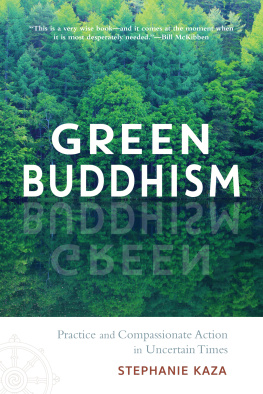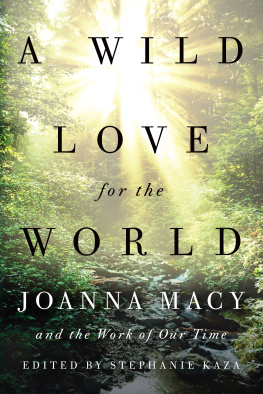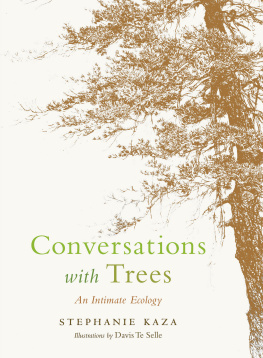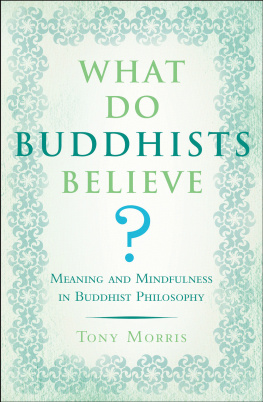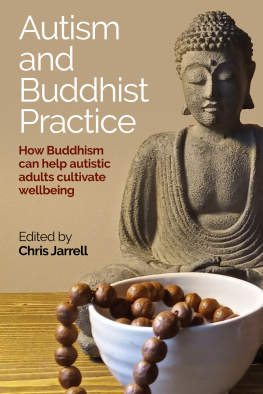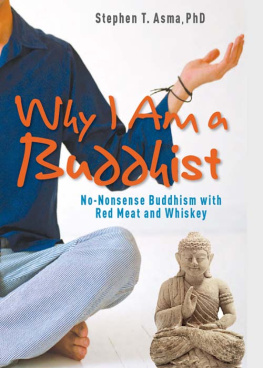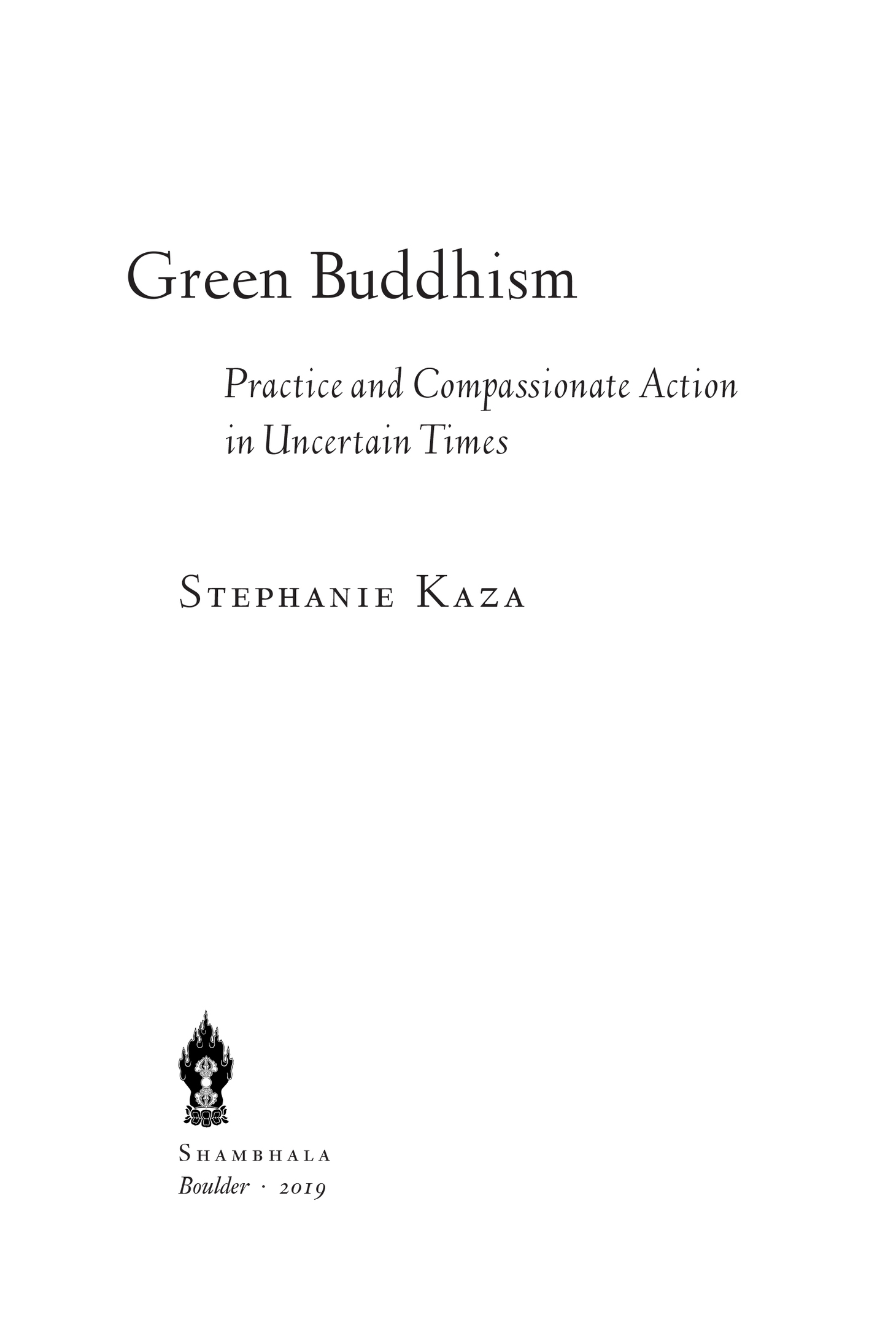Shambhala Publications, Inc.
All rights reserved. No part of this book may be reproduced in any form or by any means, electronic or mechanical, including photocopying, recording, or by any information storage and retrieval system, without permission in writing from the publisher.
Names: Kaza, Stephanie, author.
Title: Green Buddhism: practice and compassionate action in uncertain times / Stephanie Kaza.
Description: First edition. | Boulder : Shambhala, 2019. | Includes bibliographical references and index.
Subjects: LCSH : Human ecologyReligious aspectsBuddhism. | Religious lifeBuddhism.
Classification: LCC BQ 4570. E 23 K 395 2018 | DDC 294.3/377dc23
Introduction
M Y JOURNEY TO GREEN B UDDHISM , AT LEAST AS I tell the story now, began when I first discovered light. It was the early 1950s, and I was five years old, sitting on the deck off my bedroom in Buffalo, New York, held by the soft shadows of the big apple tree. The shimmering leaves, the dancing light and dark, had me spellbound in its radiance. Across the afternoon the light shifted and the sun dropped lower in the sky. I didnt want to leave. This light show was the center of the universe. Some great mystery penetrated my young consciousness. What was it?
Though I dutifully attended Sunday school, I could not connect this church activity with what Id encountered. Four years later, when my family drove across the vast North American continent to move to Portland, Oregon, there it was again, gleaming in the craggy Rocky Mountains. Here was a staggering sky-rock space on a scale way beyond anything Id ever known. A magnificent landscape, mountains of such measure I could not even comprehend what I was seeing. Far beyond the barbs of family squabbles, something very, very big entered my nine-year-old mind.
My teen years were marked by the usual school and community activities, but now I was in a different place. Oregon became home for my soul while I was struggling to become human. The sweeping tides of the Pacific Ocean, the iconic waterfalls of the Columbia Gorge, and most of all, the towering forests of the Northwest. All these shaped my sense of orientation, my sense of place, my sense of deep time and life before humans.
When I began my studies at Oberlin College, I felt sure I would concentrate on the sciences. I had taken physics, chemistry, math, biology, and I was fascinated by dissection; I thought I would become a surgeon. A year into the rich liberal arts curriculum, I went into traumatic paralysis trying to choose a major, a single perspective, a single worldview. It seemed impossible. Eventually I majored in biology, which confirmed my love of beauty in the complexity of life forms.
In my first ecology course I was introduced to a relational view, now standard in environmental studies and ecological sciences. Seeing organisms alive and in context felt much more satisfying than observing them as taxonomic specimens. By the time I graduated, ecological problems were surfacing at a despair-inducing rate, and I found myself absorbed by the plight of whales. The Vietnam War tore apart any sense of stability and meaning in my small world; I nearly lost my first great love to the killing fields. What made sense in this tragic insanity?
Not until things settled down could I turn my attention back to the mystery. By then I was exploring the magical California gateways of ocean, redwoods, dance, and ritual. When my dance teacher went to Naropa Institute in Boulder, Colorado, I followed her the next summer. High in the mountain air, sitting by clear water, listening to Chgyam Trungpa teach, I fell in lovewith everything! I learned to meditate, I absorbed the Buddhist creativity of Allen Ginsberg and Philip Glass, and found myself at a turning point.
When I returned to Santa Cruz I took up a sitting practice on my own and sat every day for five years in steadfast devotion. To what? I knew hardly anything about Buddhism, but meditation seemed like a good thing to do. Only after I finished a PhD, taught environmental ethics, couldnt get a job, and tried living in a Mendocino hippie commune, did I consider formal Zen practice. I moved into a small sangha house at the Santa Cruz Zen Center, took up daily practice as a way of life, and met my eventual ordination teacher, Kobun Chino Otogawa.
The next years took me further into both Zen and nature, as I worked first with the Point Reyes Bird Observatory and later with UC Berkeley Botanic Garden as education director. I learned the native birds and plants, the soils and rocks of northern California, and roamed the trails of Mount Tamalpais and beaches of Point Reyes. Somehow I found my way to Green Gulch Zen Center and was able to live there as a student for three years. I was lucky to be able to hear Thich Nhat Hanhs early teachings in the United States and to join his experimental retreats for children and environmentalists. His precepts of interbeing and his way of leading walking meditation had a profound effect on my Buddhist practice. I was exposed to many fine Buddhist teachers in the Bay Area such as Jack Kornfield, Maylie Scott, Norman Fischer, Blanche Hartman, and Steve Stcky, among others. I helped to organize conferences on women and Buddhism and socially engaged Buddhism and went on as many retreats as I could afford. Then a period of serious illness in my thirties led me to ponder (in a Zen sort of way), What next? What really was my life path?
In a somewhat unexpected turn, I followed one halting step after another and landed at Starr King School for the Ministry in Berkeley where I studied ethics and theology. Here I gained considerable depth in understanding human values and social systems and had the good fortune to take a class with Joanna Macy, one of the pioneers of green Buddhism in America. I volunteered for social action causes with the Buddhist Peace Fellowship and took my meditation into the marketplace. I walked the hills and paths of coastal Marin County in every season. I wrote reflective essays about relations with trees that eventually became a book (The Attentive Heart: Conversations with Trees). Where all this was going was quite unclear at the time. I seriously considered entering the Unitarian ministry, but when I realized all my sermon topics were about the environment, I decided undergraduates were a better audience. After many letters of rejection and dashed hopes, I was offered a faculty position with the Environmental Program at the University of Vermont.
At that time, there was almost no dialogue between world religions and the natural sciences and almost no moral reflection on environmental concerns outside the academy. In the 1990s the field of Religion and Ecology was born and I was quickly invited to bring my knowledge of Buddhism to interfaith dialogue. I flowed right into all the emerging conferences drawing attention to the crises we faced, and thus, my academic scholarship took shape. That long career of speaking and writing has yielded a good number of books, articles, speeches, and practice challenges. This volume represents a selection of that work, updated and drawn together here for the first time.

